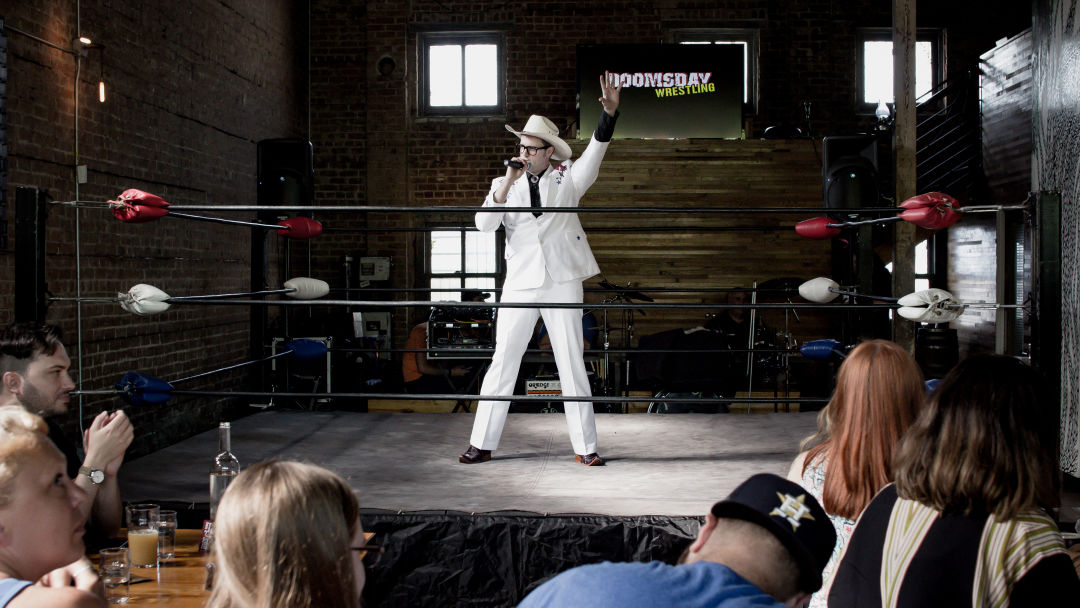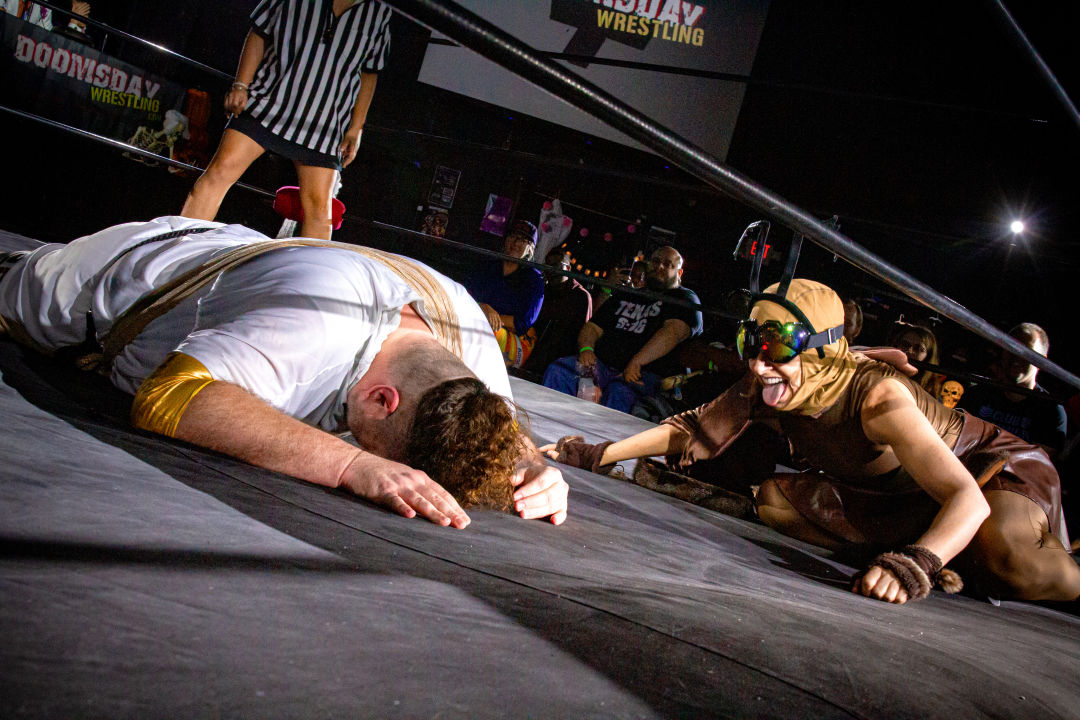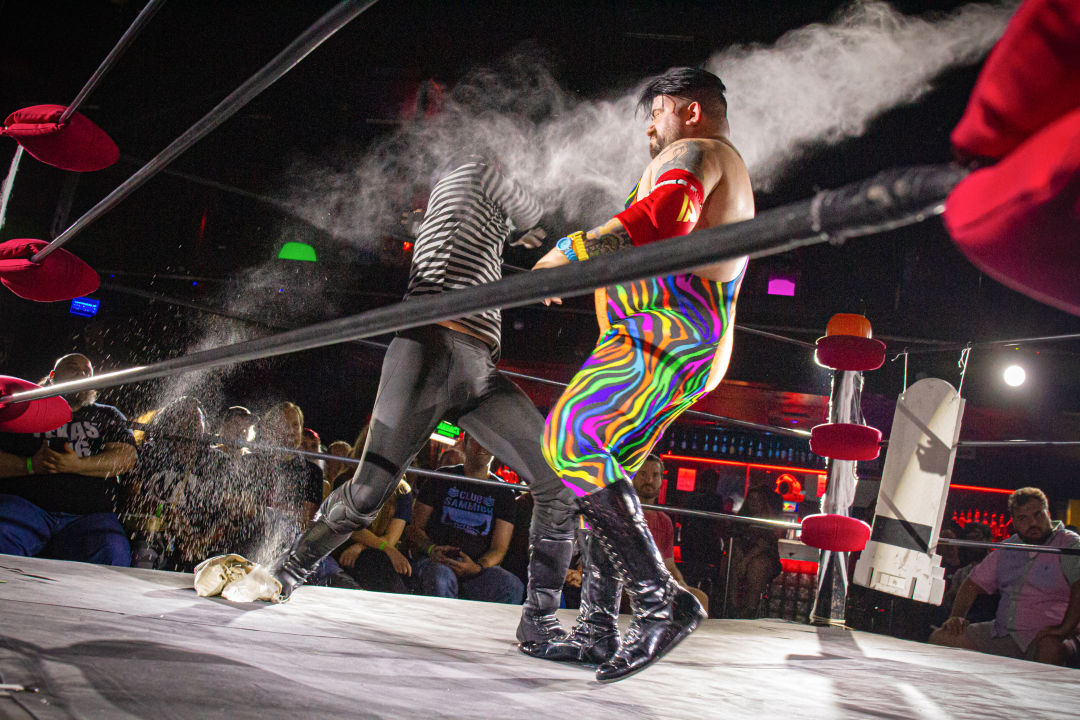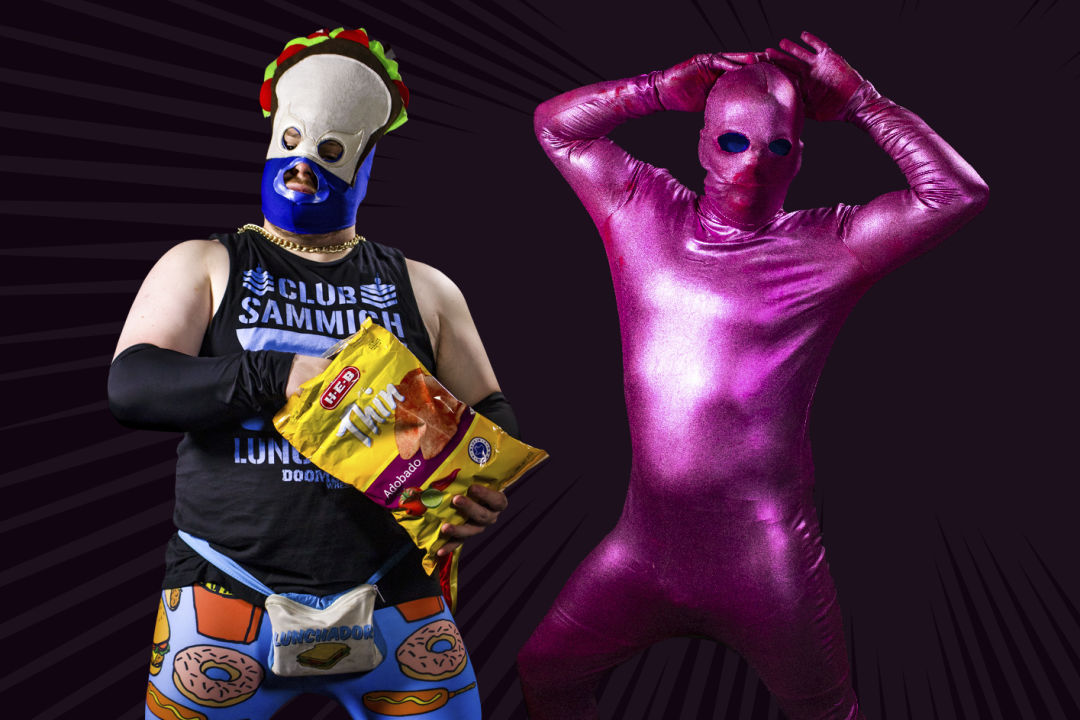Doomsday Wrestling Brings the Smack Down to H-Town

Greg Vallot, aka Tex Lonestar, emcees each Doomsday Wrestling match.
Image: Courtesy Skyler Payne
It’s a balmy Saturday night in early April, and more than 100 people are seated on chairs and benches around a wrestling ring set up inside Eureka Heights Brew Co. The already humid air buzzes with energy as the beer-soaked crowd waits for the evening’s next event to commence. Then from behind a curtained-off area, a wrestler emerges dressed as a Houston Police Department officer, a character known tonight as simply “HPD.” The crowd greets him with a deafening chorus of boos.
Roachella appears next, a “half roach, half human hybrid” in a pleated leather skirt, goggle eyes, and antenna cap, who’s met with raucous cheers as she scurries her way around the ring, throwing handfuls of plastic roaches into the audience.
The match starts with a few exaggerated skirmishes before HPD removes his clothes to music befitting Magic Mike. As he gets down to his underwear the audience quickly learns, much to their delight, that HPD actually stands for “Hot Police Daddy.” This less-clothed version of the wrestler, who was clearly losing the match before his strip show, now has the advantage. He quickly dispatches two of Roachella’s six “legs,” literally ripping the costume appendages from her body. After a brief melee with Hot Police Daddy, the insatiable insect launches herself into the air before tackling and permanently disarming her sleazy opponent, who has been reduced to what one of the emcees calls “a thin blue line.” The crowd vibrates with glee.

Roachella taunts Achilles the Heel.
Image: Courtesy Skyler Payne
This is Doomsday Wrestling, a 20-year-old amateur wrestling outfit in Houston responsible for matches as riotous as they are ridiculous. The man behind this mayhem is Greg Vallot, aka Tex Lonestar, 46, who also serves as emcee. Vallot spent much of his childhood engrossed in what is now known as World Wrestling Entertainment (WWE), the most well-known wrestling company in the country. He was instantly hooked on the theatricality of the sport. He’d imagine wrestlers, build cardboard cutouts, and practice his moves on them in his backyard—and sometimes on his dad and his dog, as well.
“I’ve always been attracted to the weirdness of wrestling, the absurdity of it,” Vallot says. “The characters all have these strange gimmicks, and I just love the idea that they are wanting to settle their differences but they wait until they’re on TV to do it.”
Vallot founded Doomsday with a group of friends back in 2003 after noticing there was a big unoccupied stage in the backyard of Helios (now popular bar Avant Garden). He decided to put it to good use with a very DIY wrestling performance. That first show included spandex outfits made by Vallot’s mother and a makeshift ring that he says he conned his father into crafting.
“I was really thinking we were going to do one show to get it out of our systems and never do it again,” Vallot says. Although he and the other organizers thought their makeshift show would be primarily attended by friends and family, when about 300 people showed up, they quickly realized they had a potential hit on their hands. By the conclusion of the show, they were all hooked and decided to keep the production going.
Doomsday Wrestling, now with its own ring—one that you can jump on and bounce people off of—puts on up to eight shows a year, mostly at Numbers Nightclub but also at New Potato and breweries like Urban South Brewery, Eureka Heights Brew Co., and Equal Parts Brewing. Audiences for the shows have steadily grown through the years as Doomsday Wrestling has picked up a cult following. It’s not out of the ordinary today to have anywhere between 200 and 600 people in attendance. Each show includes five or six matches that Vallot and his cast of more than 30 choreograph and script ahead of time. There’s a plotline that runs through each show, and at some point, a villain usually shows up and has to be neutralized before the final bell. “It might be aliens invading, or it might be an interdimensional monster that we have to all fight,” Vallot says.
While Vallot hosts the show as his Tex Lonestar character—whom he describes as “all Texan and all that”—Doomsday’s regular wrestlers are a ragtag bunch of misfits who fight it out onstage as Lonestar provides witty commentary.
There’s Time’s UP! Thomas, master of all time zones, a campy take on an ’80s wrestler decked out in neon. The Stormin’ Mormons, a team of luchador-Mormon missionaries, consult copies of the Book of Mormon for their moves—and use them to slap their opponents into submission. Then there’s Pound Cake, a body-slamming baker who uses her rolling pin of reckoning to flatten her opponents.

Crooked Dick Dunn fights dirty against Time’s UP! Thomas.
Image: Courtesy Skyler Payne
Crooked Dick Dunn is a thief who tiptoes around and has a finishing move fittingly called the “smash and grab.” Dunn is the creation of Brandon Clements, a marketing professional, videographer, and podcaster who got into wrestling much later in life than most of the sport’s fans. After watching his first Doomsday Wrestling match four years ago, Clements decided to throw his hat in the ring, creating his Dunn persona.
“The best characters are the ones that are kind of already a part of your personality but just turned up to 11,” Clements says. “I like to think of Doomsday as a cartoon, so I really wanted to come up with a character who resembled and felt like a cartoon.”

From wacky to just plain weird: Lunchadore (left) and Precious Jules.
Unlike for other members of Doomsday’s cast, Clements’s involvement in the industry extends beyond the organization. For two years, he worked as a producer and videographer for Reality of Wrestling, Houston’s more professional-grade wrestling organization founded by icon Booker T. He’s now working on a wrestling-related documentary film project.
Wrestling, Clements notes, encompasses all forms of entertainment, media, and production. “At its core, wrestling is performative, it’s extravagant, and it’s pageantry,” he says. And that’s what led him to it the most. While wrestling allows Clements to film interesting content, he says it also gives him the opportunity to step away from the camera and actually participate in all of the zany onstage action through his over-the-top character.
Therein lies the beauty of Doomsday. While the wrestling matches one might watch on TV, like the ones Clements has been involved with through Reality of Wrestling, are all about the action and involve lots of complicated physicality, Doomsday shows are more about the stories, the comedy and jokes, the zany bits, the fun.
“Those guys on TV are professionals who have had years of training,” Vallot says. “My first and foremost goal is that I just want to put on a good show. I want to make sure the show is enjoyable and fun. I want people to feel like they’re in the 1980s when they’re watching a match—like they’re really not in this era.”




